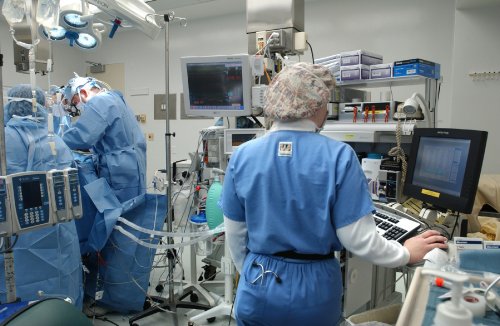
When they come on line in November, the Critical Care Tower's new operating rooms will be much larger than exisiting suites. (File photo)
New tower’s operating rooms designed with growth in mind
With adult surgical volumes at Vanderbilt Medical Center expected to rise as high as 30,000 cases next year, the new operating rooms in the Critical Care Tower under construction will be prepared to meet that demand with the latest technology and a more efficient design.
“The expansion of the ORs is part of an overall focused growth initiative around surgical volume,” said Nancye Feistritzer, M.S.N., R.N., executive hospital director for Perioperative Services. “This past year, we've had 11 new surgeons on the adult side, and next year we have 13 new surgeons coming. I think that these operating rooms will serve us well as we continue to grow the surgical program here at Vanderbilt.”

Nancye Feistritzer, M.S.N., R.N.
Feistritzer, who is head of OR planning for the Critical Care Tower addition to Vanderbilt University Hospital, said the best way to describe the 12 new ORs is “state of the art.” They will join the facility’s 19 existing ORs.
The ORs — set to begin opening in November — will continue to have the latest telemedicine capabilities, and for the first time, VMC will have both single-plane and bi-plane imaging capabilities. Two ORs were specifically designed to house these machines.
Thomas Naslund, M.D., chief of the Division of Vascular Surgery and medical director for the Critical Care Tower project, said these new technologies will help keep VMC at the forefront.
“We need new ORs because modern surgery has advanced such that added technology is needed to provide the very latest techniques and develop ever newer techniques,” Naslund said.
“These ORs have technology at the highest level anywhere. They give us the ability to add future advances in technology and greater capacity to serve our expanding surgical volume.”
The ORs will be significantly larger in order to accommodate the additional technology. Corridors outside the ORs have an additional five feet of space to store equipment.
To make best use of the additional space, Feistritzer said the design team focused on interchangeability and standardization.
“These rooms are designed with an eye toward making them multi-functional. All of the 12 rooms, with the exception of the radiology equipment, will be interchangeable. We can use them for any sort of service,” Feistritzer said.
The ORs will have shelving that is designed to keep standardized supplies, streamlining the restocking process. Subspecialty items can then be added depending on the case.
The ORs were configured into pods to maximize teamwork. Each surgical service is currently divided into a pod with its own leadership team, and the ORs will support that structure.
“Instead of having 12 rooms that are not really well connected, we're trying to have smaller configurations so that they are more easily managed and aligned with our leadership structure,” Feistritzer said. “We're trying to take that full accountability for all things about that patient population and translating it into how we use our space.”
To augment the additional OR capacity, support services are also being renovated. A consolidated blood bank to serve both VUH and the Monroe Carell Jr. Children's Hospital at Vanderbilt is under construction on the fourth floor of The Vanderbilt Clinic.
That space will also include faculty offices for the Department of Anesthesiology. Surgical Pathology will move into an expanded space on the third floor of VUH.
After VMC takes ownership of the tower in September, Feistritzer plans to use the months of September and October to orient users. The move to the ORs is set for the weekend of Nov. 7, giving OR staff one week to settle in before the intensive care units move in.
Feistritzer said she anticipates opening five ORs in November and phasing into additional rooms incrementally.
Fifteen of the 19 existing ORs will remain open. Renovations to existing ORs are on hold due to capital availability.
The current pre- and postoperative space will be renovated in January 2010 to accommodate the increased OR capacity. The vacated space of the surgical intensive care unit will serve as both a temporary pre-op preparation and post-op recovery area while the current space is renovated.
“We are looking forward to finally having state-of-the-art facilities to accommodate our expanding procedural services for the next several years,” said Mike Higgins, M.D., chair of the Department of Anesthesiology. “As a clinician, I'm excited about working in an environment that is ideal for our patients and staff. Patient flow will be streamlined and privacy improved significantly.
“It will be a challenge for the next year or so as we complete all of the renovation, but there is a bright light at the end of the tunnel, which is a facility that is efficient, safe, and a pleasure to work in,” Higgins said.













